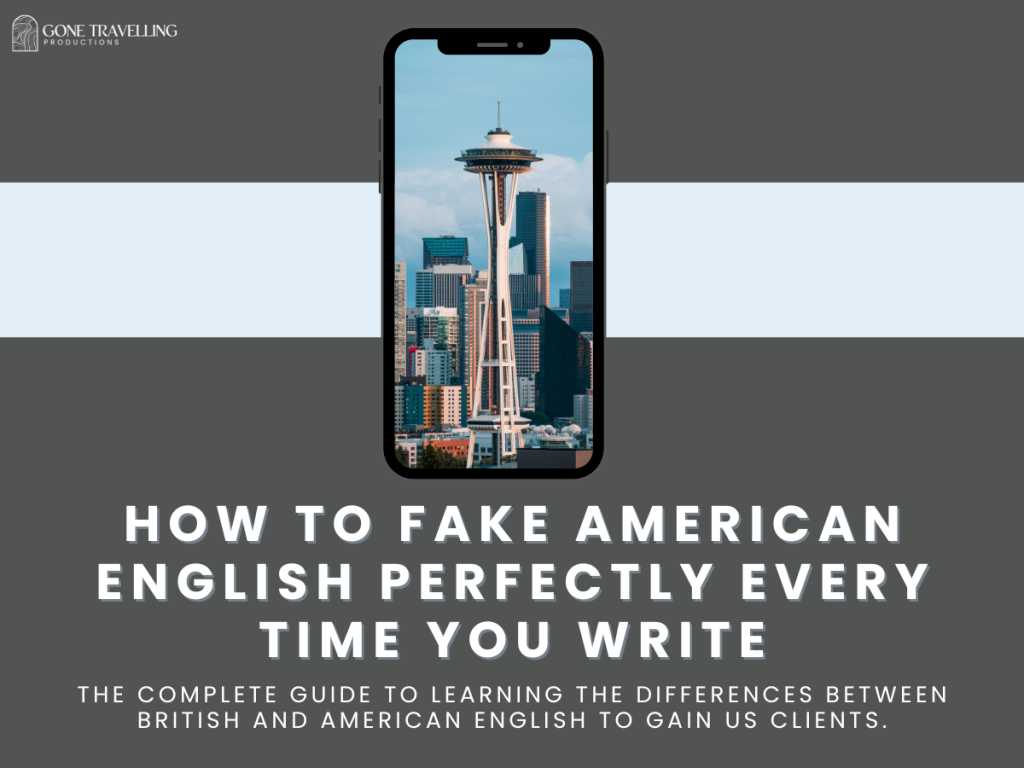A few months into freelancing as a ghostwriter for screenplays, I got my first American client. Not wanting to lose out on a job, I agreed to the project and told them that writing in American English wouldn’t be a problem. As a native English speaker from the UK, I knew that there were differences between British and American English (they say trunk, we say boot etc), but was confident it would be easy to change a few vocab words and spell colour without the ‘u’.
It would be simple right?
Nope. Embarrassingly, I sent over the first draft of that script only to receive note after note correcting my grammar and leaving question marks next to phrases that my client had absolutely no idea the meaning of.
I immediately realised the similarities in our written language were no where near as close as I had thought.
Over the years, I have learnt through client feedback, a lot of research, and constant texts to the Americans in my life (” Do you say this?”) I’ve been able to garner a comprehensive understanding of what it means to actually write in American English.
I’ve split these differences into four key areas for you to consider:
- Tenses
- Spellings
- Vocab
- Grammar
Below is an extensive list of the most common differences between British and American English, as well as some little-known subtleties that when implemented, can truly make your writing as believable as if written by a true yank.
The Differences Between British and American English
1. Tenses:
Believe it or not, English speakers from the UK and the US use tenses very differently, or to be specific, verb conjugation and spellings.
Irregular Past Participles:
Typically in verb conjugation for past participles both British and American English add ‘ed’ to the end of the verb. With irregular verbs, however, the two language forms can use different rules.
There are some verbs which British English treat as irregular and add ‘-t’ to the end of, whereas American English treats them as regular with an ‘-ed’.
For example:
| British English | American English |
|---|---|
| Learnt | Learned |
| Dreamt | Dreamed |
| Spelt | Spelled |
| Lit | Lighted |
| Leapt | Leaped |
| Spoilt | Spoiled |
There are also verbs which both British and American English treat as irregular but conjugate completely differently. Here are some key irregular past participles to memorise:
| British English | American English |
|---|---|
| Shrank | Shrunk |
| Dived | Dove |
Passive vs Active Present Tense
This is one of the most common and bizarre differences between American and British English. In the UK we say ‘stood’ all the time to refer to something in the present, e.g. he’s stood right there. ****In American English, not only is this not correct, but they also have no idea what you are talking about. This is one of those Britishisms that Americans just can’t quite compute.
To get technical, in the UK we commonly use the Present Perfect Passive where Americans would implement the Present Progressive. The Present Perfect Passive emphasizes the result or outcome of an action that started in the past and continues up to the present moment, whereas the Present Progressive emphasises the ongoing nature of an action happening in the present or around the present time.
Here are some examples to help you:
| British English | American English |
|---|---|
| He is stood there. | He is standing there. |
| She is sat on the chair. | She is sitting on the chair |
| They are laid down. | They are lying down. |
2. Spellings
The UK ‘u’
One of the most recognisable aspects of British English is that we use an additional ‘u’ in the spellings of many words. Here’s some to remember:
| British English | American English |
|---|---|
| Colour | Color |
| Doughnut | Donut |
| Neighbour | Neighbor |
| Aluminium | Aluminum |
| Favour | Favor |
| Honour | Honor |
| Harbour | Harbor |
| Behaviour | Behavior |
Word Endings
It is also common to see major differences in word endings between British and American English such as ‘-ise’ versus ‘-ize’ or ‘-re’ instead of ‘-er’ respectively.
| British English | American English |
|---|---|
| Realise | Realize |
| Organise | Organize |
| Analyse | Analyze |
| Recognise | Recognize |
| Utilise | Utilize |
| Centre | Center |
| Theatre | Theater |
| Metre | Meter |
| Litre | Liter |
| Fibre | Fiber |
It is also important to recognise the different spellings when it comes to single or double consonants. British English more commonly uses double consonants in the middle of a word compared to the American singular, for instance:
| British English | American English |
|---|---|
| Traveller | Traveler |
| Cancelled | Canceled |
| Labelled | Labeled |
| Fulfilment* | Fulfillment* |
*watch out for instances like this where the rule flips!
3. Vocab
Of course, there are almost endless vocabulary differences between British and American English that come up all the time! Here’s a list to get you started or words you may not realise differ:
| British English | American English |
|---|---|
| Underground | Subway |
| Trousers | Pants |
| Boot | Trunk |
| Cinema | Movies |
| ‘Half Eight’ | Eight Thirty |
| Advert | Commercial |
| Lift | Elevator |
| Rubbish | Trash |
| Hob | Stove |
| Lorry | Truck |
| Chips | Fries |
| Jumper | Sweater |
| Biscuit | Cookie |
| Tap | Faucet |
| Trainers | Sneakers |
Directions
This difference comes up in almost every project I work on: directional vocab. In British English, there is an ‘-s’ or -’st’ added to the end of some words that is omitted in American English.
| British English | American English |
|---|---|
| Towards | Toward |
| Backwards | Backward |
| Amongst | Among |
| Amidst | Amid |
4. Grammar
Quotation Marks
In British English, single quotation marks (‘) are typically used to show direct speech or quotations within a sentence, while double quotation marks (“) are reserved for full quotations. For instance, one might write, “She said, ‘I’ll be there at five o’clock’”
In American English, it is more common to use double quotation marks for both instances, e.g., “She said, “I’ll be there at five o’clock””.
Prepositions
British and American English also use prepositions differently. This is a more subtle shift between the two but one that when used correctly can signify fluency in American English.
In British English, the preposition ‘at’ is used to signify a time or place, whereas in American English you will see ‘on’ or ‘in’ respectively.
| British English | American English |
|---|---|
| At the weekend. | On the weekend. |
| At college. | In College. |
| At that moment. | In that moment. |
Why Learn American English?
Freelancing is all about selling! Whilst it may not seem important at the moment to spend time learning and practising writing between American and British English, being able to switch between the two can vastly open up your potential client market.
Using British English is perfect for clients from the UK or Europe who typically learn British English as their second language. It is also closest to the spellings and usage in Australia and New Zealand with a few small differences that can easily be adapted to.
By then adding American English to your skills set you can open up to clients across the US and Canada as well as the many countries who learn American English in schools. This equates to thousands of new work opportunities and projects that you will now qualify for.
Tips to Learn American English
- Practice: It may seem like a hassle right now to learn these differences and manually employ them, not to mention the time spent proofreading for mistakes, but over time your ability to switch between the written forms does and will become natural. Before writing, I now simply have to make a mental note of whether I am using American or British English and can then write seamlessly in either.
- Download Grammarly.com: This software is a lifesaver when it comes to correcting small language errors. You can change between checking for British or American English as often as you need, and it quickly highlights any basic spelling or grammar mistakes. This is also a great way to recognise the minor errors and get used to avoiding them when you write.
- Read American Texts: Now you know the major differences between American and British English, you’ll suddenly start noticing them everywhere! Try to actively read American books, blogs, and social media posts with the intention of noticing specific ‘Americanisms’. Make a note anytime you spot something that stands out and then try to implement it into your own writing at a later point.
Perfecting American English as a British English user can take time. Be patient and if you do receive a correction from a client, thank them, implement the change, and make a note to not make that mistake in the future. Over time it gets easier and the mistakes will get less.
So long as your writing is of high quality and fits your client’s brief, most won’t care about a few ‘Britishisms’ here or there, in fact, I often have clients curious about the differences and happy to learn alongside me.
Are there any more differences that I missed? Leave them in a comment down below to share with the community!
Happy Writing!
Like this? Read Related Posts:
How to Find a Ghostwriter to Make Your Story Shine
The complete guide to how to find, choose, and hire a ghostwriter, including how much ghostwriters cost…
30 Ways to Immediately Improve Your Productivity
The ultimate productivity hacks and tips for freelancers to become more productive in one day.
10 Expert Steps to Build Your Writing Self Confidence
Writing advice to improve self-confidence and overcome self-doubt.







Leave a comment